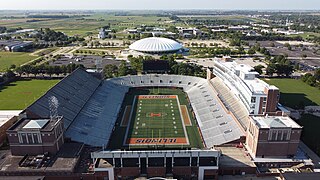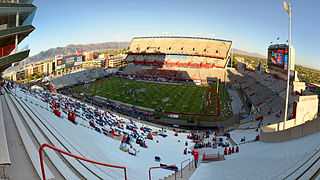
CEFCU ('sef-kyü) Stadium, formerly known as Spartan Stadium, is an outdoor athletic stadium on the west coast of the United States, located in the Spartan Keyes neighborhood of central San Jose, California. Owned by San José State University, the venue is the longtime home of Spartan football; it also hosts the university's commencement ceremony on Memorial Day weekend, and occasional high school football games. Known as Spartan Stadium for over eight decades, it was renamed in 2016.

Memorial Stadium is a stadium on the campus of the University of Illinois Urbana-Champaign in Champaign, Illinois, United States. The stadium, used primarily for football, is a memorial to the university's students who died in World War I; their names are engraved on the nearly 200 pillars surrounding the stadium's façade. With a capacity of 60,670, the stadium is primarily used as the home of the university's Fighting Illini football team.

James Gamble Nippert Memorial Stadium is an outdoor stadium in Cincinnati, Ohio, on the campus of the University of Cincinnati. Primarily used for American football, it has been the home field of the Cincinnati Bearcats football team in rudimentary form since 1901 and as a permanent concrete stadium since 1915, making it the fourth-oldest playing site and fifth-oldest stadium in college football, respectively.

Rice–Eccles Stadium is an outdoor college football stadium located on the campus of the University of Utah in Salt Lake City, Utah. It is the home field of the Utah Utes of the Big 12 Conference. It was built to serve as the stadium for the Opening and Closing ceremonies of 2002 Winter Olympics, a role it is expected to reprise for the 2034 Winter Olympics.

Darrell K Royal Memorial Stadium, located in Austin, Texas, on the campus of the University of Texas, has been home to the Longhorns football team since 1924. The stadium has delivered a home field advantage with the team's home record through November 24, 2023 being 399–122–10 (.761). The official stadium seating capacity is 100,119, making the stadium the fourth largest in the Southeastern Conference, the seventh largest stadium in the United States, and the ninth largest stadium in the world.

David Booth Kansas Memorial Stadium is a college football stadium in Lawrence, Kansas, on the campus of the University of Kansas. The stadium was opened in 1921, and is the seventh oldest college football stadium in the country, and is widely recognized as the oldest west of the Mississippi River. It is the home stadium of the Kansas Jayhawks football team.

Memorial Stadium is a stadium in Bloomington, Indiana, United States. It is primarily used for football, and has been the home of Indiana Hoosiers football since its opening in 1960. It is the 15th largest football stadium in the Big Ten Conference, with a capacity of 52,626. The field has a conventional north-south alignment, at an approximate elevation of 771 feet (235 m) above sea level.

Arizona Stadium is an outdoor college football stadium in the southwestern United States, located on the campus of the University of Arizona in Tucson, Arizona. It is the home field of the Arizona Wildcats of the Big 12 Conference.

Bill Snyder Family Stadium is a stadium in Manhattan, Kansas. It is used for American football, and is the home field of the Kansas State University Wildcats football team. It is named after the family of head coach Bill Snyder. Over the past 31 seasons – from 1990 through the 2022 season – K-State is 169–51–1 (.767) at home.

Lane Stadium is a college football stadium in the eastern United States, located on the campus of Virginia Polytechnic Institute and State University in Blacksburg, Virginia. The playing surface of the stadium is named Worsham Field. The home field of the Virginia Tech Hokies of the Atlantic Coast Conference (ACC), it was rated the number one home field advantage in all of college football in 2005 by Rivals.com. In 2007, it was ranked #2 on ESPN.com's "Top 10 Scariest Places To Play." The stadium is named for Edward Hudson Lane, a former student, local businessman, and Virginia Tech booster, while the playing surface is named for Wes Worsham, a university donor and booster.

Aggie Memorial Stadium is an outdoor football stadium in the southwestern United States, located on the campus of New Mexico State University in Las Cruces, New Mexico. It is the home field of the New Mexico State Aggies of Conference USA.

Jack Trice Stadium is a stadium located in Ames, Iowa, United States. Primarily used for college football, it is the home field of the Iowa State Cyclones. It is named in honor of Jack Trice, Iowa State's first African American athlete, who died of injuries sustained during a 1923 game against Minnesota. The stadium opened on September 20, 1975, with a 17–12 win over Air Force.

The Memorial Athletic and Convocation Center, often referred to as the MAC Center and the MACC, is a multi-purpose arena on the campus of Kent State University in Kent, Ohio, United States. The building is primarily used as an athletic venue that is home to five Kent State Golden Flashes varsity athletic teams: men's basketball, women's basketball, women's volleyball, women's gymnastics, and wrestling. In addition, it hosts commencement exercises, speakers, and concerts throughout the year. The building houses the offices of the Kent State Athletic Department and the coaches of each of the university's varsity athletic teams.

Fairfield Stadium was a stadium in Huntington, West Virginia. It was primarily used for football, and was the home field of the Marshall University football team between 1928 and 1990, prior to the opening of Joan C. Edwards Stadium.

The Kent State Golden Flashes are the athletic teams that represent Kent State University. The university fields 19 varsity athletic teams in the National Collegiate Athletic Association (NCAA) at the Division I level with football competing in the Football Bowl Subdivision. Kent State is a full member of the Mid-American Conference (MAC) and has been part of the MAC East division since it was created in 1998. Official school colors are Kent State Blue and Kent State Gold.

The Kent State Golden Flashes football team is a varsity intercollegiate athletic team of Kent State University in Kent, Ohio. The team is a member of the Mid-American Conference East division, and competes in the National Collegiate Athletic Association (NCAA) at the Division I level in the Football Bowl Subdivision (FBS). The Golden Flashes played their first game in 1920 and since 1969 have played their home games at Dix Stadium. Following the 2022 season, Kenni Burns was selected as head coach for the Golden Flashes.

Cameron Stadium is an outdoor football stadium adjacent to the campus of Washington & Jefferson College in Washington, Pennsylvania.

Memorial Stadium was a multi-purpose stadium in Kent, Ohio, United States, on the campus of Kent State University. Its primary use was as the home field for the Kent State Golden Flashes football team and also served as the home venue for the KSU men's track and field team. The football and track teams had already been playing on the site since 1941, but with temporary bleachers for seating. The permanent grandstand built and dedicated in 1950, which also included a press box, was the first phase of the stadium, and was later followed by a duplicate grandstand on the opposite side of the field in 1954. Initial plans called for the seating to eventually surround the field, though these plans were largely never realized. During the 1960s, additional bleacher seats were added separate from the two main grandstands on all sides of the field, and brought seating capacity to approximately 20,000 by 1965.

Olga Mural Field at Schoonover Stadium is a baseball venue located on the campus of Kent State University in Kent, Ohio, United States. It is home to the Kent State Golden Flashes baseball team, a member of the National Collegiate Athletic Association (NCAA) in Division I and the Mid-American Conference East Division. The field opened in 1966 and was previously known as Gene Michael Field from 1990 to 2003. The field was renamed in late 2003 and renovated in 2005 with additional upgrades made from 2006 through 2008 and again in 2013 to 2014. It has a seating capacity of 1,148 people with a Shaw Sports Turf synthetic playing surface.

Rockwell Field was a multi-purpose athletic field on the campus of Kent State University in Kent, Ohio, United States. It was the first home venue for the Kent State Golden Flashes football and the first permanent home for the KSU baseball program. The field, sometimes referred to as "Normal Field", also hosted football games for the Kent State University School. Rockwell Field served as the home field for Kent State football from the team's inception in 1920 through the 1940 season, the baseball team from circa 1920 through the 1941 season, and the men's track team from their foundation in 1922 through the 1940 season. It was replaced by a new athletic complex that included a field for football with a track and an adjacent baseball field. The new football field and track, later to become Memorial Stadium by 1950, were ready for the 1941 football and 1942 track seasons, while the baseball field opened in 1942.



























